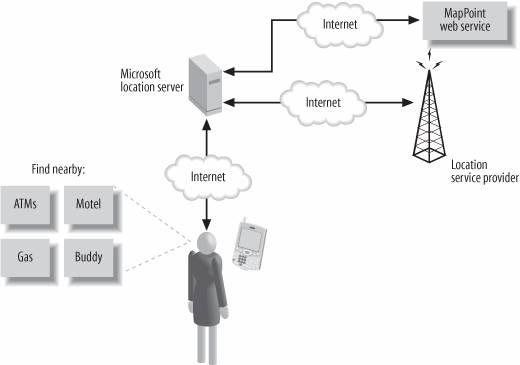Section 9.2. How Does Location Server Work?
9.2. How Does Location Server Work?Microsoft Location Server does not require GPS-like hardware to get real-time locations; instead, it locates a provisioned user's mobile device by communicating with a mobile operator. In a typical scenario, a user requests her position using a client that communicates with Microsoft Location Server; this client can be a mobile phone (such as a SmartPhone) or a portable computer (such as a laptop). When Microsoft Location Server receives the request from the client, it identifies the mobile operator for the user and sends a location request to the mobile operator. The mobile operator responds by sending back the real-time location of the user, expressed as latitude and longitude coordinates. Microsoft Location Server then returns that location to the user's client, where it can be used for rendering a map or finding nearby points of interests, depending on the application. All communications that are specific to a mobile operator are hidden from end users and developers. Thus, Microsoft Location Server works as an aggregator for mobile operators by abstracting implementation details specific to the mobile operator to obtain a real-time location. Figure 9-1 summarizes this process. Figure 9-1. How Microsoft Location Server works One important thing to keep in mind is that the accuracy of the locations returned by the Microsoft Location Server depends on the mobile operators and methods used to locate the devices on their networks. For example, some cell phone carriers use cell tower triangulation technique to determine the location of a phone; in this method the phone's location is determined by the cell towers around it. As you can imagine, this method does not always yield an accurate location. Some carriers use an assisted GPS technique, which results in a very accurate location of the phone. Table 9-1 provides an overview of technologies used by different network carriers and the approximate location accuracy of each technique used.
Now that you know how Microsoft Location Server works in general, let's look at the internals to understand its architecture. |
EAN: 2147483647
Pages: 136